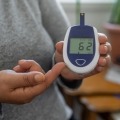Diabetes Tech Has Been Notably Absent From Type 1 Pregnancies. Could a New Study Change That?
By April Hopcroft
 The use of automated insulin delivery systems has been frustratingly out of reach in type 1 pregnancies, but a new study suggests that these systems can be both safe and effective.
The use of automated insulin delivery systems has been frustratingly out of reach in type 1 pregnancies, but a new study suggests that these systems can be both safe and effective.
The use of automated insulin delivery (AID) has remained frustratingly out of reach for many pregnant people with diabetes. Although research has shown that most pregnant people with type 1 diabetes struggle to achieve pregnancy-specific glycemic targets, many of the advances in diabetes technology in recent years haven’t yet made their way to anyone carrying a child.
While some studies have shown benefits of CGMs in pregnancy for both pregnant people and their babies, there has been little research on the safety and efficacy of AID in pregnant people with type 1 diabetes.
But a new study could help change that. Dr. Helen Murphy, Professor of Medicine at the University of East Anglia, UK, presented results from a study of Ypsomed’s CamAPS FX AID system in pregnancy. The study showed that people on automated insulin delivery had better control of their blood glucose and fewer low blood sugar events.
Why is CamAPS FX being investigated in pregnancy?
Although the CamAPS FX system is not yet approved in the US, this AID system was approved in Europe and Australia in 2020 for use in pregnancy complicated by type 1 diabetes.
CamAPS FX is unique because it allows pregnancy-specific glucose targets of 81-90 mg/dL, rather than the standard target of 100 mg/dL allowed through most commercial AID systems. In this study, participants used the lower target of 81-90 mg/dL from 16 to 20 weeks of pregnancy onward.
Glycemic targets in pregnancy are typically lower than those for nonpregnant people with diabetes. The ADA recommends the following time in range targets:
-
At least 70% of time spent within a tighter glucose range between 63-140 mg/dL (rather than the usual time in range of 70-180 mg/dL)
-
Less than 25% time above 140 mg/dL
-
Less than 4% time below 63 mg/dL
What were the key findings?
The study, which was presented at the EASD 2023 conference, included 124 pregnant people with type 1 diabetes who were between 18 and 45 years old. All study participants used Dexcom G6 CGMs and either received standard insulin pump therapy or the CamAPS FX AID system.
The study showed that pregnant people using AID had better glycemic control with less hypoglycemia.
-
Average time in range was 68% in the AID group, compared to 56% in the insulin pump group – a very significant finding, according to Murphy.
-
Participants using AID spent less time in hyperglycemia, had more overnight time in range, and lower A1C levels.
-
There was no increase in maternal hypoglycemia, despite the improvements in time in range.
-
Participants using AID had 7.7 lbs less gestational weight gain and lower rates of gestational hypertension.
The improvements in time in range were consistent regardless of A1C at the beginning of the study and throughout pregnancy. There were no statistically significant differences in birth weight or health outcomes for children born to trial participants using the CamAPS FX algorithm versus standard pump therapy.
What do these findings mean?
The CamAPS FX AID system was associated with nearly 11% improvement in time in range compared to standard insulin pump therapy in a group of pregnant people with type 1 diabetes. Beyond time in range benefits, Murphy said that using AID was linked to a healthier pregnancy overall with less gestational weight gain and less gestational hypertension.
Put simply: Trial participants who used AID had “less work, less worry, and a more enjoyable pregnancy experience."
According to Dr. Satish Garg and Dr. Sarit Polsky, both from the Barbara Davis Center for Diabetes at the University of Colorado, these results support the use of AID in pregnancy to improve glycemic control and maybe even positively impact pregnancy outcomes. Garg and Polsky noted the importance of using customizable glucose targets within the pregnancy target range (63-140 mg/dL) to safely and effectively manage glycemic control.
Ultimately, Murphy emphasized that CGM alone or with insulin pump therapy is not enough for optimal glycemic control in pregnancy. She concluded that AID systems – specifically CamAPS FX – should be offered where approved to all pregnant people with type 1 diabetes.
Learn more about diabetes management during pregnancy:







